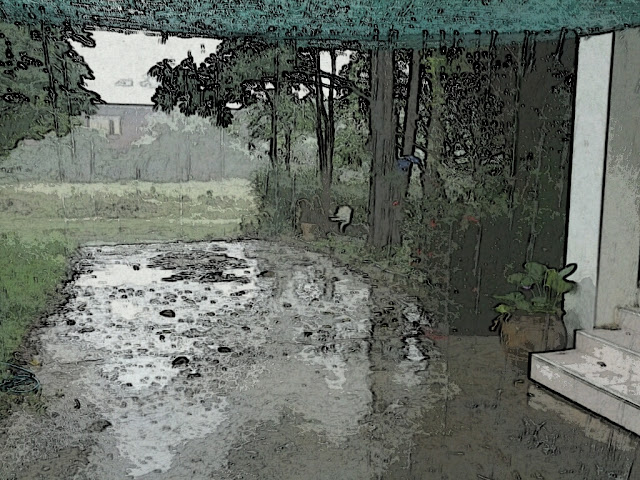Just for the record, because I know you can't tell from the pictures of my previous post, those cows are about 5 feet tall. And did you know that cows come when you call? (If you can stop them from eating the grass, that is).
Anyway, exciting news on the home front. Rica sent some Horse Chestnut tincture from the States, and sure enough, in just a couple of days, the chronic swelling of Genla's feet is greatly improved. There's a lot of natural things whose health proprieties Genla strongly believes in—guavas, turmeric, garlic, and ginger to name a few. In NYC, yogurt was high on that list. And yet Genla really struggled with phlegm. A few times I suggested that Genla experiment with taking a break from yogurt to see if the dairy was contributing to the problem. Needless to say, suggesting to a Tibetan that yogurt might be the cause of a problem didn't yield the desired result. However, here in Thailand, we have no yogurt. And he has almost no phlegm. Until someone gave us some yogurt, and we conducted an experiment. Yogurt yielded more phlegm. Now Genla is happy to go without. That's a long way of illustrating that if Genla doesn't already know about the health benefits, he's often pretty skeptical, especially of natural remedies. But if it works, it works. Sometimes its just hard to get him to try. He's quite pleased with his feet though. So hopefully he'll be open to trying a few more things that I had shipped from America for him. He doesn't like to be fussed over though, so it's a delicate balance.
As a yoga teacher, and even more so now that I'm venturing into healing, I've had one major surprise. Time and time again, what shocks me is how much discomfort and pain people are willing to live with. At the beginning of each session, I always ask my backcare students how their back is, specifically, is there any pain. The conversation often went something like this:
"Are you in pain now?"
"No."
"Have you been in pain this week?"
"No."
"Not at all?"
"No."
"You have not been in pain since the last time we met?"
(Here's where things would often start to reveal themselves)
"Not more than usual"
...And so I'd keep delving. Once, after a similar dialogue, one of my students said, "Well, I did fly to California this week, and when I got off the plane, the pain was excruciating. I had to lie down in my hotel room for quite a while. I couldn't do anything it hurt so much. It often happens like that after a long flight. But then it passes. So it's fine. No problem."
Not only was I shocked, but this was the first time that I saw the big picture. To me it's simple. Reoccurring, immobilizing pain is a problem. Yet I regularly saw yoga students who had a very different relationship to pain than I do. Even truly disruptive or acute pain. One has to be skillful in helping people understand that they don't actually have to be in pain. And of course, not everyone can be pain free, but for many, many people, relief—albiet to varying degrees—is entirely possible.
There's many factors play into one's relationship to pain. I'm sure there' a lot written about it, but here are a few cursory thoughts. I have found that people become accustomed to pain. Very often they've tried many things, and nothing works. So they quite understandably become resigned to it. Additionally, people with chronic pain seem to lose perspective about it; they forget it's not normal. This often turns into a resistance to healing, because in their mind, nothing is wrong. Another factor that seems particularly prevalent in NYC, is that people feel they don't have enough time to address the issue, so they simply live in pain. Other people are distrusting of non-Western medicine, and so rather than try something else, they continue with something that only partially works or has ill side effects. Others are overly trusting of Western medicine. I've had plenty of people say, "The doctor said there's nothing I can do." Or, "Surgery is the only option." This is sometimes particularly strange when other forms of medicine/therapies have very common remedies for the same conditions. As such, it's rewarding to be able to help those people who have been told that they can't be helped.
At first (and it's still tough), the fact that some people seem dedicated to living in pain was purely mind boggling to me. Sometimes I would meet someone with a problem, and I would say, "Oh, that's a simple one. Try this." And for one reason or another, they'd prefer not to. To see that person again, and to find them still in unnecessary pain, is a challenge. But slowly I am learning not say anything, or at least not to push. And slowly, slowly, I'm learning how to be increasingly skillful with varying types of people. And I'm also learning to just drop it with others. It can be quite difficult. But it does encourage me to keep learning more about how to heal the human body, and the mind. The more I know about the body and various healing techniques, the more I can help, accurately and with precision. And the more I know about the mind, the more I can respond appropriately to people just where they are.
Anyway, exciting news on the home front. Rica sent some Horse Chestnut tincture from the States, and sure enough, in just a couple of days, the chronic swelling of Genla's feet is greatly improved. There's a lot of natural things whose health proprieties Genla strongly believes in—guavas, turmeric, garlic, and ginger to name a few. In NYC, yogurt was high on that list. And yet Genla really struggled with phlegm. A few times I suggested that Genla experiment with taking a break from yogurt to see if the dairy was contributing to the problem. Needless to say, suggesting to a Tibetan that yogurt might be the cause of a problem didn't yield the desired result. However, here in Thailand, we have no yogurt. And he has almost no phlegm. Until someone gave us some yogurt, and we conducted an experiment. Yogurt yielded more phlegm. Now Genla is happy to go without. That's a long way of illustrating that if Genla doesn't already know about the health benefits, he's often pretty skeptical, especially of natural remedies. But if it works, it works. Sometimes its just hard to get him to try. He's quite pleased with his feet though. So hopefully he'll be open to trying a few more things that I had shipped from America for him. He doesn't like to be fussed over though, so it's a delicate balance.
As a yoga teacher, and even more so now that I'm venturing into healing, I've had one major surprise. Time and time again, what shocks me is how much discomfort and pain people are willing to live with. At the beginning of each session, I always ask my backcare students how their back is, specifically, is there any pain. The conversation often went something like this:
"Are you in pain now?"
"No."
"Have you been in pain this week?"
"No."
"Not at all?"
"No."
"You have not been in pain since the last time we met?"
(Here's where things would often start to reveal themselves)
"Not more than usual"
...And so I'd keep delving. Once, after a similar dialogue, one of my students said, "Well, I did fly to California this week, and when I got off the plane, the pain was excruciating. I had to lie down in my hotel room for quite a while. I couldn't do anything it hurt so much. It often happens like that after a long flight. But then it passes. So it's fine. No problem."
Not only was I shocked, but this was the first time that I saw the big picture. To me it's simple. Reoccurring, immobilizing pain is a problem. Yet I regularly saw yoga students who had a very different relationship to pain than I do. Even truly disruptive or acute pain. One has to be skillful in helping people understand that they don't actually have to be in pain. And of course, not everyone can be pain free, but for many, many people, relief—albiet to varying degrees—is entirely possible.
There's many factors play into one's relationship to pain. I'm sure there' a lot written about it, but here are a few cursory thoughts. I have found that people become accustomed to pain. Very often they've tried many things, and nothing works. So they quite understandably become resigned to it. Additionally, people with chronic pain seem to lose perspective about it; they forget it's not normal. This often turns into a resistance to healing, because in their mind, nothing is wrong. Another factor that seems particularly prevalent in NYC, is that people feel they don't have enough time to address the issue, so they simply live in pain. Other people are distrusting of non-Western medicine, and so rather than try something else, they continue with something that only partially works or has ill side effects. Others are overly trusting of Western medicine. I've had plenty of people say, "The doctor said there's nothing I can do." Or, "Surgery is the only option." This is sometimes particularly strange when other forms of medicine/therapies have very common remedies for the same conditions. As such, it's rewarding to be able to help those people who have been told that they can't be helped.
At first (and it's still tough), the fact that some people seem dedicated to living in pain was purely mind boggling to me. Sometimes I would meet someone with a problem, and I would say, "Oh, that's a simple one. Try this." And for one reason or another, they'd prefer not to. To see that person again, and to find them still in unnecessary pain, is a challenge. But slowly I am learning not say anything, or at least not to push. And slowly, slowly, I'm learning how to be increasingly skillful with varying types of people. And I'm also learning to just drop it with others. It can be quite difficult. But it does encourage me to keep learning more about how to heal the human body, and the mind. The more I know about the body and various healing techniques, the more I can help, accurately and with precision. And the more I know about the mind, the more I can respond appropriately to people just where they are.
 |
| Medical Drawings from a temple wall in Bangkok |






